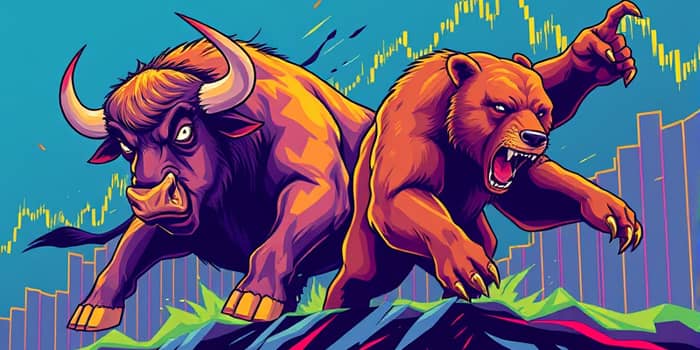Financial markets move in cycles of optimism and pessimism, creating opportunities and challenges for investors. By understanding the forces that drive upward and downward trends, individuals can cultivate resilience and strategic foresight in their investment journey.
Across generations, market participants have witnessed exhilarating growth periods followed by sharp downturns. Recognizing the signs of each phase empowers investors to make informed decisions rather than reacting purely on emotion.
Definitions and Origins
A bull market is defined as a period of sustained and substantial growth in asset prices, typically marked by a rise of 20% or more from recent lows. During these phases, widespread investor optimism and enthusiasm drive demand, often fueled by strong corporate earnings and positive economic data.
Conversely, a bear market represents a period of sustained and substantial decline, usually a drop of 20% or more from recent highs. Pessimism prevails, liquidity tightens, and average investors may retreat to perceived safe-haven assets to preserve capital.
The terms “bull” and “bear” date back to 18th-century London, inspired by the way these animals attack: bulls thrust horns upward, while bears swipe downward. In trading circles, “bulls” came to describe confident buyers, and “bears” referred to cautious sellers or short-sellers anticipating declines.
Measuring Market Trends
Investors commonly use a 20% threshold to categorize bull and bear markets, but time frame matters greatly. Trends can unfold over days or decades, each with distinct implications.
- Secular trends: multi-decade directional movements that shape entire generations of investors.
- Primary trends: lasting months to years, these cycles often reflect economic expansions and contractions.
- Secondary trends: brief fluctuations of weeks to months, sometimes viewed as corrections within larger trends.
Tracking broad market indexes such as the S&P 500, Dow Jones Industrial Average, and Nasdaq Composite helps quantify these shifts. Historical data since 1872 reveal that bulls occur as often as bears, but their characteristics differ.
These statistics illustrate that bull markets generally last more than twice as long and deliver significantly larger gains compared to the losses seen in bear markets.
Economic and Psychological Drivers
Market trends are propelled by a complex interplay of macroeconomic forces and human emotions. Recognizing these drivers provides valuable context to the observed price movements.
- Strong GDP growth, low unemployment, rising corporate profits, and expanding valuation multiples all underpin bull markets by reinforcing confidence and encouraging investment.
- Economic contraction, rising unemployment, falling earnings, and shrinking consumer spending erode confidence, creating a self-reinforcing feedback loop in bear markets.
Investor sentiment often becomes a self-fulfilling prophecy: as optimism builds, money flows into equities, driving prices higher. In downturns, fear spreads, liquidity dries up, and defensive strategies prevail.
Historical Illustrations
The 1990s tech boom stands as a hallmark bull market, with the S&P 500 soaring over 400% from October 1990 to March 2000. Yet the subsequent dot-com crash erased nearly 40% of market value by September 2002, demonstrating how exuberance can precede sharp reversals.
Another defining bull run began in March 2009 after the Global Financial Crisis, lasting over a decade and delivering nearly 300% gains. Notably, the market bottomed before many economic indicators had fully recovered, underscoring the market’s forward-looking nature.
Bear markets of the Great Depression, the dot-com collapse, the 2007–2009 Financial Crisis, and the 2020 pandemic-driven sell-off each offer lessons in volatility, risk management, and the importance of maintaining perspective during extreme conditions.
Strategies for Investors
During bull markets, many investors adopt a growth-oriented stance, focusing on high-quality equities and sectors poised for expansion. A long-term disciplined perspective can help avoid chasing short-lived winners while capturing broad market momentum.
In bear markets, defensive allocation often proves prudent. Investors may increase exposure to high-grade bonds, maintain cash reserves, or seek shifting to defensive and stable assets like gold and dividend-paying stocks. Some pursue hedging strategies or selective short positions.
Diversification across asset classes and geographies helps smooth returns over the full market cycle. Monitoring indicators such as the CBOE Volatility Index (VIX), moving averages, and consumer confidence surveys can offer additional insights into prevailing sentiment.
Navigating Market Phases with Confidence
Understanding the cyclical nature of market trends equips investors to react deliberately rather than emotionally. By anticipating the ebb and flow of optimism and fear, individuals can set appropriate entry and exit points, reducing the likelihood of panic-driven decisions.
Embracing volatility as part of the investment journey fosters resilience. Periods of decline provide opportunities to acquire high-quality assets at discounted valuations, while rallies can be harnessed to rebalance portfolios and realize gains.
Ultimately, a balanced approach that integrates fundamental analysis, risk management, and emotional discipline offers the best chance to thrive across bull and bear markets. Recognizing that cycles repeat and that patience often yields rewards will empower investors to remain steadfast even in turbulent times.
References
- https://www.coinbase.com/learn/crypto-basics/what-is-a-bull-or-bear-market
- https://en.wikipedia.org/wiki/Market_trend
- https://www.schwab.com/learn/story/bull-vs-bear-understanding-market-phases
- https://robinhood.com/us/en/learn/articles/3i6hIwhY75uWjZUZiLFTFT/what-are-bull-and-bear-markets/
- https://www.fidelity.com/learning-center/smart-money/bear-vs-bull-market
- https://www.cmcmarkets.com/en-sg/trading-guides/bear-and-bull-market-explained
- https://www.rbcgam.com/en/ca/learn-plan/investment-basics/the-bulls-the-bears/detail
- https://awealthofcommonsense.com/2024/10/defining-bull-and-bear-markets/










